It was love at first bite – and the main reason I kept ordering in from the local Lebanese. Moussaka in the Levantine style has little to do with the Greek version, but is equally delicious. Learn how to make this simple yet luxurious meze dish at home!
Before I moved to Istanbul, I lived a very different life in London. Suited, tubing into work every morning and working until late (actually, the latter never changed).
Although I tried to eat as much homemade and natural food as possible, take-out several times a week was inevitable. Particularly in my last year, when I was living on my own while my partner was in Istanbul to get the house in order.
On the regular list was a Lebanese. Obviously.
But while I was obviously keen on their hummus shawarma and stuffed vine leaves, there was only one dish i always ordered. Mousakaat bel zeit. Lebanese moussaka.
What is the difference between the different types of moussaka?
I had no idea why the name of the dish had moussaka in it. As far as I was concerned, this was nothing like moussaka at all.
Sure, there was aubergine and, sure, there was tomato sauce. But that’s where the similarities ended.
As I arrived in Istanbul, this was one of the first dishes I was keen to recreate and research. Turns out the Greek variety isn’t the only moussaka in town. It’s not even the original!
Moussaka is a family of similar dishes popular throughout the Middle East, the Eastern Mediterranean and the Balkans. Most versions are based on aubergine, some on potato. A tomato sauce is often involved, as is meat (though not always).
The word moussaka itself derives from Arabic musaqqa’a, suggesting a likely Levantine origin.
In the birthplace of agriculture and many a culinary delight, moussaka is a meze dish of cooked aubergine, tomato sauce and, often, chickpeas. It can be eaten warm, but is more often enjoyed at room temperature alongside a few other small dishes. It’s also known under different names, like maghmour or mousaka batinjan.
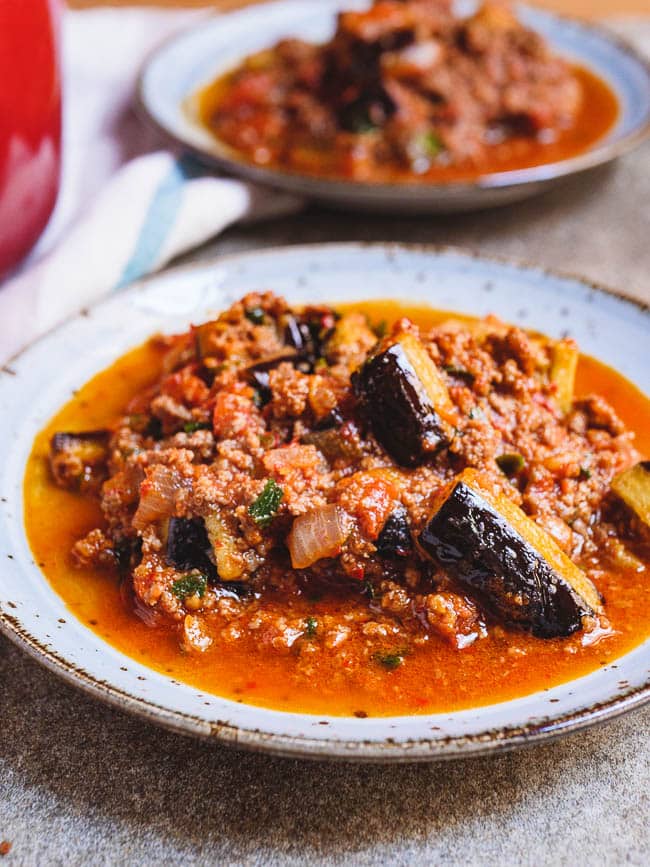
A little up north, in neighbouring Turkey, the chickpeas are swapped for lamb and make a simple stew. It’s one of my go-to dishes for easy but amazingly tasty weeknight dinner. In the Balkans, it’s a similar but baked dish where potatoes typically substitute aubergine, while the meat is typically pork or beef.
And the Greek one? It’s the most removed from the original moussaka of them all. It was created as late as the 1920s by a French-trained Greek chef, and is as such a French-Greek fusion dish. A mouthwateringly delicious one at that, if I may add.
Still, the importance of tomato sauce suggests the dish isn’t actually that much older elsewhere. Tomatoes were only introduced to the Middle East in the first half of the 19th century, by a British consul with a penchant for horticulture.
How to make Lebanese moussaka
In many ways, then, Lebanese moussaka is a vegetarian aubergine stew. That description is, however, nowhere near doing it justice.
Silky and rich aubergine, a fresh and delicious tomato sauce and a lovely bite from chickpeas…once you start it’s difficult to stop!
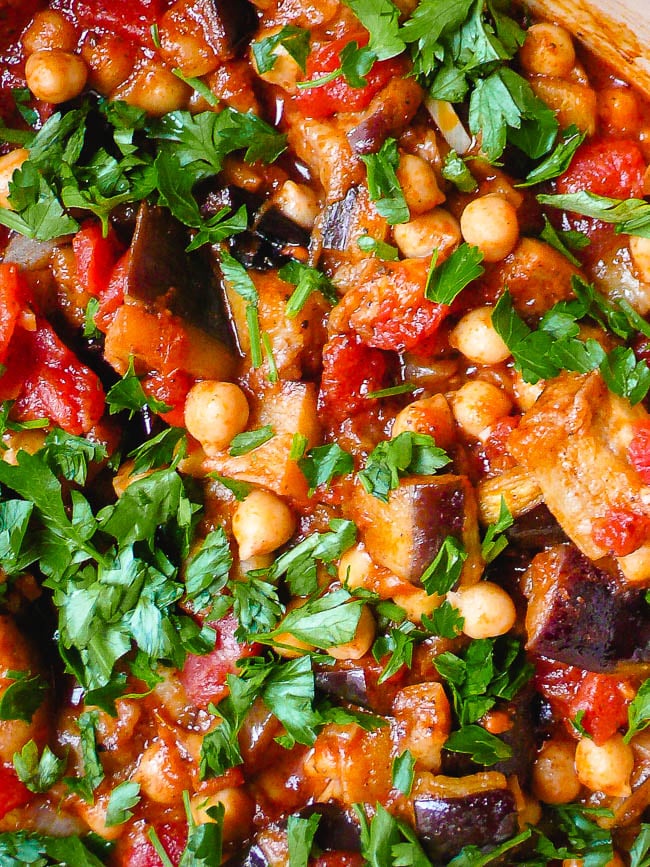
In its original form, the aubergine (eggplant if you’re American) would have been fried in copious amounts of delicious local olive oil. This is what makes the aubergines so silky smooth and rich, and is a common method in Middle Eastern aubergine recipes. If your olive oil is good, that flavour is hard to beat.
Today, however, many choose to roast the aubergines instead. This is easier and less messy. For those mindful of calories (even good olive ones), it also gives you complete control over how much oil the aubergines soak in. I wouldn’t go so far as to say they’re equally delicious, but they’re close enough for me to usually head down this route.
That doesn’t mean I’m skimpy on the olive oil, though! Whether frying or roasting, copious amounts of good-quality olive oil are crucial to getting the rich flavour and silky texture of this vegan Lebanese recipe. I use a mild extra virgin olive oil from the Turkish Ayvalık region.
What sets the Lebanese moussaka apart from similar dishes such as Turkish aubergine salad, is the use of spices. Gentle but warming spices commonly associated with the Middle East.
I find allspice and cinnamon to be the ultimate combination here, though you could go for a Lebanese 7-spice mix if you’re so inclined.
In the West, tinned chickpeas are ubiquitous. Traditional cooks in the Middle East won’t go anywhere near them. While some brands are decent, cooking your own chickpeas from dried isn’t difficult and, once you’ve done it a few times, gets you exactly the texture you need for the dish at hand.
I prefer fairly soft and large chickpeas for this. But I leave it to you whether you cook your own or use tinned or jarred.
How to serve Lebanese moussaka
While some refer to the dish as an aubergine stew, it is commonly served as part of a meze spread. That is, as one of several small dishes such as baba ganoush, hummus and fattoush.
In this case, serve it at room temperature with a generous helping of crusty fresh bread or soft flatbreads alongside.
However, it also works great in the way you usually enjoy stew: Served warm, with a side of rice and salad.
Lebanese moussaka is great for making ahead. It keeps for several days in the fridge, and can be served warm or at room temperature.
The recipe yields a large batch, enough for dinner as a main course for 4 or meze for 8-12 people.
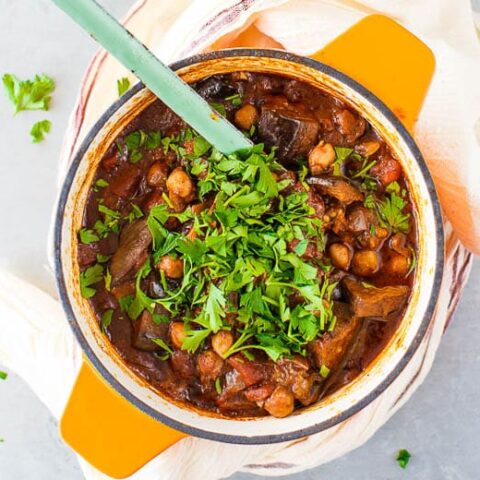
Lebanese moussaka (Maghmour)
Ingredients
- 1 kg aubergine (eggplant), eggplant
- 130 ml olive oil, I use a mild extra virgin, divided
- 1 onion, finely chopped
- 5 garlic cloves, finely chopped
- 2 tsp ground allspice
- 1 tsp ground cinnamon
- 800 g tomato, skinned and chopped (fresh or tinned)
- 2 tsp sugar
- 1 Tbsp lemon juice
- 500 g chickpeas (cooked), from 200 g dry chickpeas, soaked and boiled, or 2×400 g cans, rinsed and drained
- water
- finely chopped flat-leaf parsley, to garnish
- salt and pepper
How I make it
- Preheat the oven to
230 °C, fan. Line two baking sheets with baking parchment.
- Peel off stripes of the skin of the aubergine so it resembles a zebra pattern, then chop into 1 ½ cm (½ in) cubes. Mix with 100 ml (⅖ cup) of the olive oil and some salt. Transfer to the two baking sheets and bake until nearly fully (but not quite fully) softened, around 15 minutes. I place the two baking sheets in the middle and high in the oven. Keep an eye on them and swap their places if one cooks faster than the other (ovens vary a lot on this). Set aside.
- Heat a thick-bottomed pot over medium/ low heat. Fry the onion in the remaining 2 Tbsp (30 ml) olive oil until softened, but not coloured, stirring regularly. This usually takes 8-10 minutes. Add the garlic, allspice, cinnamon and a little salt and pepper. Fry for 30 seconds, stirring constantly, then add the tomatoes, sugar and 100 ml water. Mix well, bring to the boil and leave to simmer, covered, for 10-15 minutes to allow the flavours to settle.
- Add the lemon juice, roasted aubergine and cooked chickpeas. Continue to cook, covered, until the aubergine is completely soft, another 10-20 minutes. Taste for seasoning, adding more salt, pepper, sugar or lemon juice to taste.
- Serve warm or at room temperature, garnished with a generous sprinkling of finely chopped flat-leaf parsley.


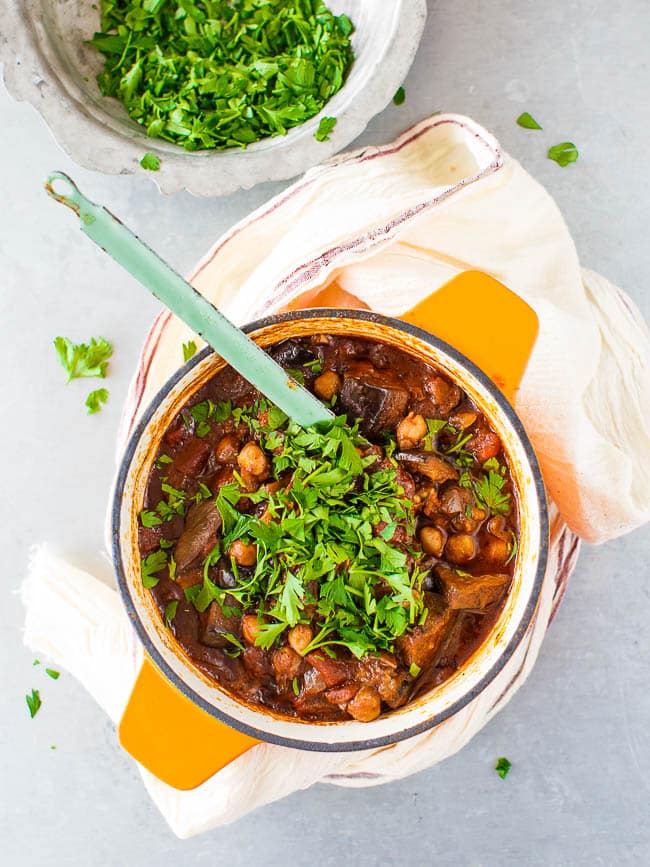


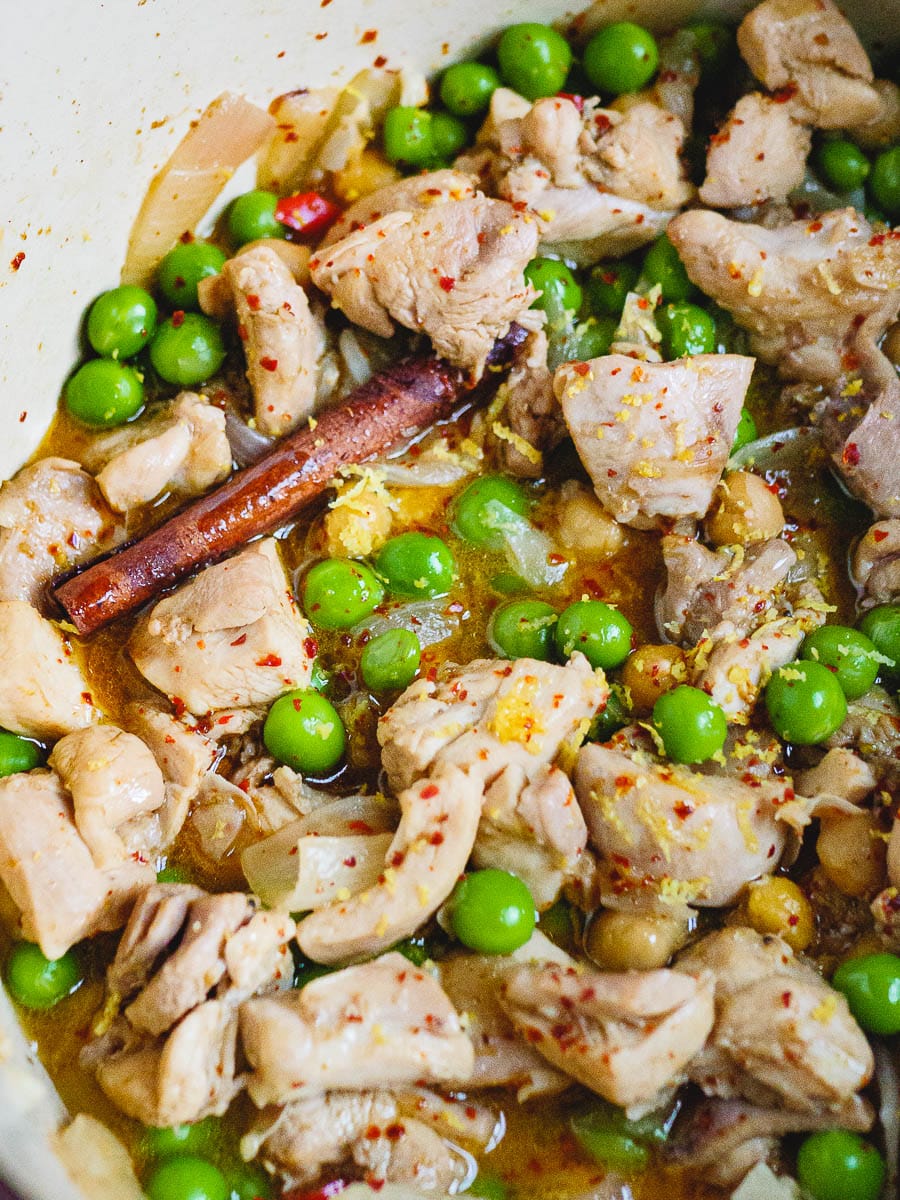
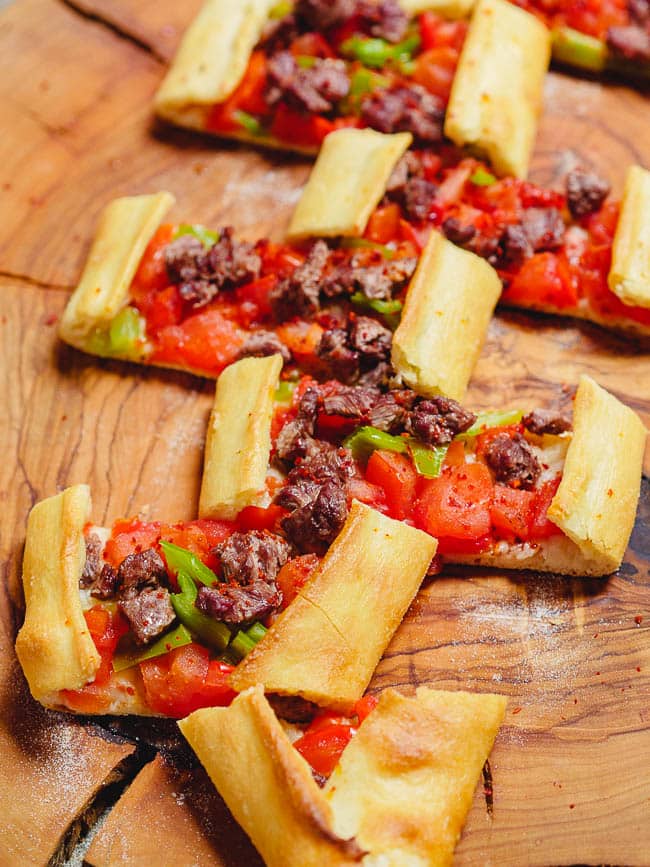
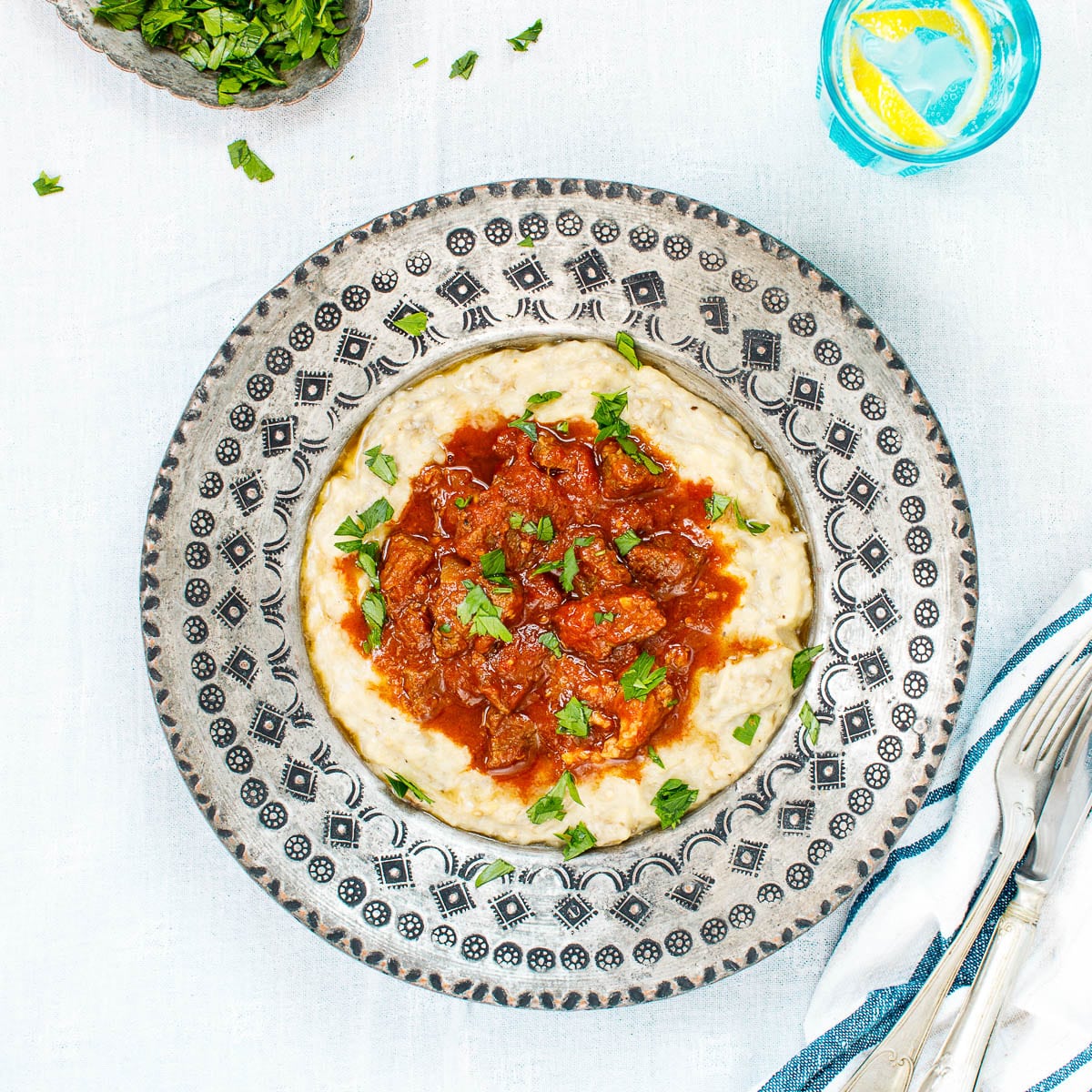
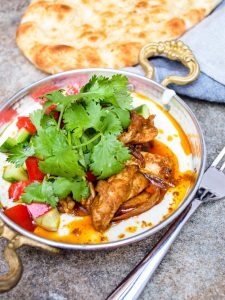
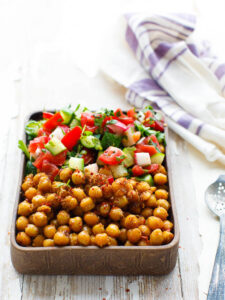
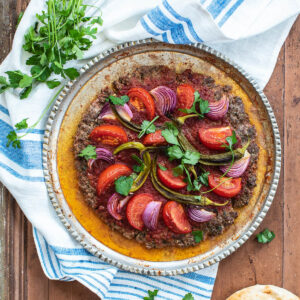




12 responses
Very, very good!!
I have just stumbled across this recipe via your newsletter. I am going to buy the ingredients today. Thank you so much for writing in such detail about how to get the best out of a humble aubergine.
Thanks for sharing, hope you’ll enjoy it!
Great easy recipe brings back fond memories of my aunties cooking this
How wonderful to hear! Thanks so much for sharing.
I had this in a Lebanese restaurant in Hampton Court and loved it. I decided to cook the aubergines in quite a lot of olive oil in a cast iron pot because the late, great Michael Moseley showed us how good it is for us, and I think this improved the flavour as well as the nutrition. I’m a big fan of Middle Eastern cuisine and this, along with Shakshuka and Baba Ganoush, are near the top of my favourite dishes
How wonderful to hear! Thanks for sharing.
Thank you for generously sharing this recipe. I made it having just had enjoyed the same dish in a Lebanese restaurant in London, Diwan on Thayer Street. Your recipe is very good. I used tinned tomatoes and chick peas – both high quality brands. I served it as you suggest at room temperature with warm flatbreads. Delicious!
This was really lovely, thank you! We ate it lukewarm with rice but the leftovers will be eaten chilled and with Arabic bread. Tasted similar to a mezze I had in dubai but I think the eggplant in that was fried.
I tried it with mint as well, I added both dried mintand the leaves to the tomato soup and it was amazing!
Moussaka means “cold” so this is why Maghmour is refer to as Lebanese moussaka because they can both be eaten cold. I have seen some websites which seem to think moussaka has to be layered.
This recipe you have posted is very authentic Lebanese. I make this also with lentils in the place of chick peas sometimes because my partner doesn’t like chick peas.
I usually make a harira type soup the next day and add the leftover maghmour to it. After I have picked out all the aubergine pieces and eaten them dipped in labneh first!
Thank you for sharing this recipe.
Thank you for your kind comment, and for the additional information on maghmour! Much appreciated. It is indeed a shame that too many websites don’t bother with research and make sweeping assumptions based on what (far too often very little) they know…